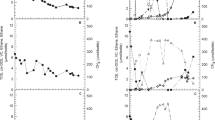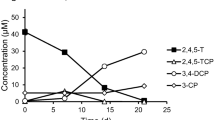Abstract
Radiolabeled tetrachloroethene (PCE) and carbon tetrachloride (CT) were added to batch systems containing a lactate-enrichment culture displaying apparent dehalorespiration abilities to analyze the influence of mixtures on product distribution. Both CT and PCE were readily dechlorinated, although significant carbon disulfide (CS2) formation was observed during CT transformation. Calculated 1,2-14C-PCE recoveries for biotic treatments were between 91 and 104%, but an inability to recover products such as CS2 led to lower recoveries of 14C-CT (55 to 62%). While the majority of activity in 14C-CT-spiked treatments was recovered in the volatile fraction, 14CO2 increased significantly over time. 1,2-14C-PCE was primarily recovered in volatile and non-strippable fractions, but a significant increase in 14CO2 relative to cell-free controls suggested that the presence of a non-specific dechlorination pathway complementing dehalorespiration. The addition of both CT and PCE inhibited the transformation of the individual compounds and reduced the percentages recovered as 14CO2. However, the magnitude of these reductions was not severe and appeared to be the result of slower overall transformation rather than a complete inhibition of mineralization pathways.
Similar content being viewed by others
References
Adamson DT &Parkin GF (2000) Impact of mixtures of chlorinated aliphatic hydrocarbons on a high-rate, tetrachloroethenedechlorinating enrichment culture. Environ. Sci. Technol. 34: 1959–1965
Assaf-Anid N,Hayes KF &Vogel TM (1994) Reductive dechlorination of carbon tetrachloride by cobalamin(II) in the presence of dithiothreitol. Environ. Sci. Technol. 28: 246-252
Bagley DM &Gossett JM (1995) Chloroform degradation in methanogenic methanol enrichment cultures and by Methanosarcina barkeri 227. Appl. Environ. Microbiol. 61: 3195-3201
Boyd SA &Mikesell MD (1990) Dechlorination of chloroform by Methanosarcina strains. Appl. Environ. Microbiol. 56: 1198-1201
Bradley PM &Chapelle FH (1999a) Methane as a product of chloroethene biodegradation under methanogenic conditions. Environ. Sci. Technol. 33: 653-656
Bradley PM &Chapelle FH (1999b) Role for acetotrophic methanogens in methanogenic biodegradation of vinyl chloride. Environ. Sci. Technol. 33: 3473-3476
Bradley PM &Chapelle FH (2000) Acetogenic microbial degradation of vinyl chloride. Environ. Sci. Technol. 34: 2761-2763
Criddle CS &McCarty PL (1991) Electrolytic model system for reductive dechlorination in aqueous environments. Environ. Sci. Technol. 25: 973-978
Dolfing J &Beurskens JEM (1995) Advances in microbial ecology (pp 143-206). Plenum Press, New York, NY
Egli C,Scholtz R,Cook AM &Leisinger T (1987) Anaerobic dechlorination of tetrachloromethane and 1,2-dichloroethane to degrabable products by pure cultures of Desulfitobacterium sp. and Methanobacterium sp. FEMS Microbiol. Lett. 43: 257-261
Egli C,Tschan T,Scholtz R,Cook AM &Leisinger T (1988) Transformation of tetrachloromethane to dichloromethane and carbon dioxide by Acetobacterium woodii. Appl. Environ. Microbiol. 54: 2819-2824
Egli C,Stromeyer S,Cook AM &Leisinger T (1990) Transformation of tetrachloromethane and chloroform to CO2 by anaerobic bacteria is a non-enzymic process. FEMS Microbiol. Lett. 68: 207-212
Fathepure BZ &Vogel TM (1991) Complete degradation of polychlorinated hydrocarbons by a two-stage biofilm reactor. Appl. Environ. Microbiol. 57: 3418-3422
Fennell DE,Carroll AB,Gossett JM &Zinder SH (2000) Assessment of indigenous reductive dechlorinating potential at a TCE-contaminated site using microcosms, polymerase chain reaction analysis, and site data. Submitted to Environ. Sci Technol.
Freedman DL &Gossett JM (1989) Biological reductive dechlorination of tetrachloroethylene and trichloroethylene to ethylene under methanogenic conditions. Appl. Environ. Microbiol. 55: 2144-2151
Galli R &McCarty PL (1990) Biotransformation of 1,1,1-trichloroethane, trichloromethane, and tetrachloromethane by a Clostridium sp. Appl. Environ. Microbiol. 55: 837-844
Glod G,Angst W,Holliger C &Schwarzenbach R (1997) Corronoid-mediated reduction of tetrachloroethene, trichloroethene, and trichlorofluoroethene in homogenous aqueous solution: Reaction kinetics and reaction mechanisms. Environ. Sci. Technol. 31: 253-260
Glod G,Broadman U,Angst W,Holliger C, &Schwarzenbach R (1997) Cobalamin-mediated reduction of cis-and transdichloroethene, 1,1-dichloroethene, and vinyl chloride in homogeneous aqueous solution: Reaction kinetics and mechanistic considerations. Environ. Sci. Technol. 31: 3154-3160
Gossett JM (1987) Measurement of Henry's law constants for C1 and C2 chlorinated hydrocarbons. Environ Sci Technol 21: 202-208
Holliger C. andSchraa G. (1994) Physiological meaning and potential for application of reductive dechlorination by anaerobic bacteria. FEMS Microbiol. Rev. 15: 297-305
Holliger C,Wohlfarth G &Diekert G (1999) Reductive dechlorination in the energy metabolism of anaerobic bacteria. FEMS Microbiol. Rev. 22: 383-398
Kriegman-King MR &Reinhard M (1992) Transformation of carbon tetrachloride in the presence of sulfide, biotite, and vermiculite. Environ. Sci. Technol. 26: 2198-2206
Kriegman-King MR &Reinhard, M. (1994) Transformation of carbon tetrachloride by pyrite in aqueous solution. Environ. Sci. Technol. 28: 692-700
Krone UE,Thauer RK &Hogenkamp HPC (1989) Reductive dehalogenation of chlorinated C1-hydrocarbons mediated by corronoids. Biochem. 28: 4908-4914
Lewis TA,Morra MJ &Brown PD (1996) Comparative product analysis of carbon tetrachloride dehalogenation catalyzed by cobalt corrins in the presence of thiol or titanium (III) reducing agents. Environ. Sci. Technol. 30: 292-300
Madsen EL (1998) Epistemology of environmental microbiology. Environ Sci. Technol. 32: 429-439
Magli A,Messmer M &Leisinger T (1998) Metabolism of dichloromethane by the strict anaerobe Dehalobacterium formicoaceticum. Appl. Environ. Microbiol. 64: 646-650
Maymo-Gatell X,Chien YT,Gossett JM &Zinder, SH (1997) Isolation of a bacterium that reductively dechlorinates tetrachloroethene to ethene. Science 276: 1568-1571
McCarty PL &Semprini L (1994) Handbook of remediation (pp 87-116). Lewis Publishers, Boca Raton, FL
Neumann A,Wohlfarth G &Diekert G (1998) Tetrachloroethene dehalogenase from Dehalospirillum mulitvorans: cloning, sequencing of the ipceA gene in Escherichia coli. J. Bacteriol. 180: 4140-4145
Reardon, KF (1994) Challenges for in situ bioremediation of chemical mixtures. In Toxicology of chemical mixtures (pp 505-538). Academic Press, Inc.
Rickard DT (1969) The chemistry of iron sulphide formation at low temperatures. Stockholm Contributions to Geology 26: 67-95
Schumacher W,Holliger C,Zehnder AJB &Hagen WR (1997) Redox chemistry of cobalamin and iron-sulfur cofactors in the tetrachloroethene reductase of Dehalobacter restrictus FEBS Microbiol. Lett. 409: 421-425
Schwarzenbach RP,Gschwend PM &Imboden, DM (1993) Environmental organic chemistry. JohnWiley & Sons, Inc., New York, NY
Stromeyer SA,Stumpf K,Cook AM &Leisinger T (1992) Anaerobic degradation of tetrachloromethane by Acetobacterium woodii: Separation of dechlorinative activities in cell extracts and roles for vitamin B12 and other factors. Biodegradation 3: 113-123
Vogel TM &McCarty PL (1985) Biotransformation of tetrachloroethylene to trichloroethylene, dichloroethylene, vinyl chloride, and carbon dioxide under methanogenic conditions. Appl. Environ. Microbiol. 49: 1080-1083
Author information
Authors and Affiliations
Rights and permissions
About this article
Cite this article
Adamson, D.T., Parkin, G.F. Product distribution during transformation of multiple contaminants by a high-rate, tetrachlorethene-dechlorinating enrichment culture. Biodegradation 12, 337–348 (2001). https://doi.org/10.1023/A:1014347524144
Issue Date:
DOI: https://doi.org/10.1023/A:1014347524144




